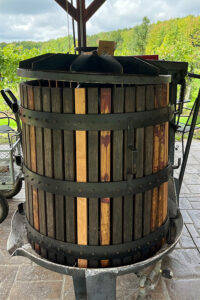Wine Quality and Recognition
 The wines produced in the Grand River Valley have gained recognition both locally and nationally for their quality and distinct characteristics. The cool climate influences the grapes’ acidity levels, contributing to wines with crispness and balance. Wineries in the region often offer a range of wines from dry to sweet, catering to various preferences and showcasing the diversity of styles that can be achieved in this unique terroir.
The wines produced in the Grand River Valley have gained recognition both locally and nationally for their quality and distinct characteristics. The cool climate influences the grapes’ acidity levels, contributing to wines with crispness and balance. Wineries in the region often offer a range of wines from dry to sweet, catering to various preferences and showcasing the diversity of styles that can be achieved in this unique terroir.
Microclimate
The Grand River Valley benefits from a microclimate created by the presence of Lake Erie to the north. The lake moderates temperatures, preventing extreme cold in winter and excessive heat in summer, which helps extend the growing season, allowing grapes to ripen fully and develop complex flavors.
The proximity to Lake Erie also helps mitigate the risk of spring frost damage, as the lake’s thermal mass delays the warming of the air, protecting budding grapevines from late frosts that can harm young shoots.
The region receives adequate rainfall throughout the year, which is essential for grapevine health and growth. Well-drained soils in the valley floor and on gently sloping hillsides prevent waterlogging, ensuring that grapevines do not suffer from excessive moisture.
Grape Varieties
The Grand River Valley is particularly known for its success with a variety of grape cultivars:
Cold-Hardy Hybrids: Varieties such as Vidal Blanc, Seyval Blanc, and Chambourcin are well-suited to the region’s climate. These hybrids are bred to withstand colder temperatures while still producing quality fruit.
Vinifera Varieties: With advancements in vineyard management and selection of suitable sites, some vinifera varieties like Riesling, Chardonnay, Pinot Noir, and Cabernet Franc are also cultivated successfully in the Grand River Valley.
Viticultural Practices
Local winemakers and vineyard managers employ modern viticultural practices to optimize grape quality and yield. Techniques such as canopy management, irrigation where necessary, and disease prevention are carefully implemented to ensure healthy vines and high-quality fruit.
In conclusion, the Grand River Valley in Ohio benefits from a favorable wine growing climate characterized by its microclimate, adequate heat accumulation, and moderated temperatures from Lake Erie. These factors together create an ideal environment for cultivating a variety of grape cultivars, resulting in wines that reflect the region’s terroir and garner appreciation from wine enthusiasts.
